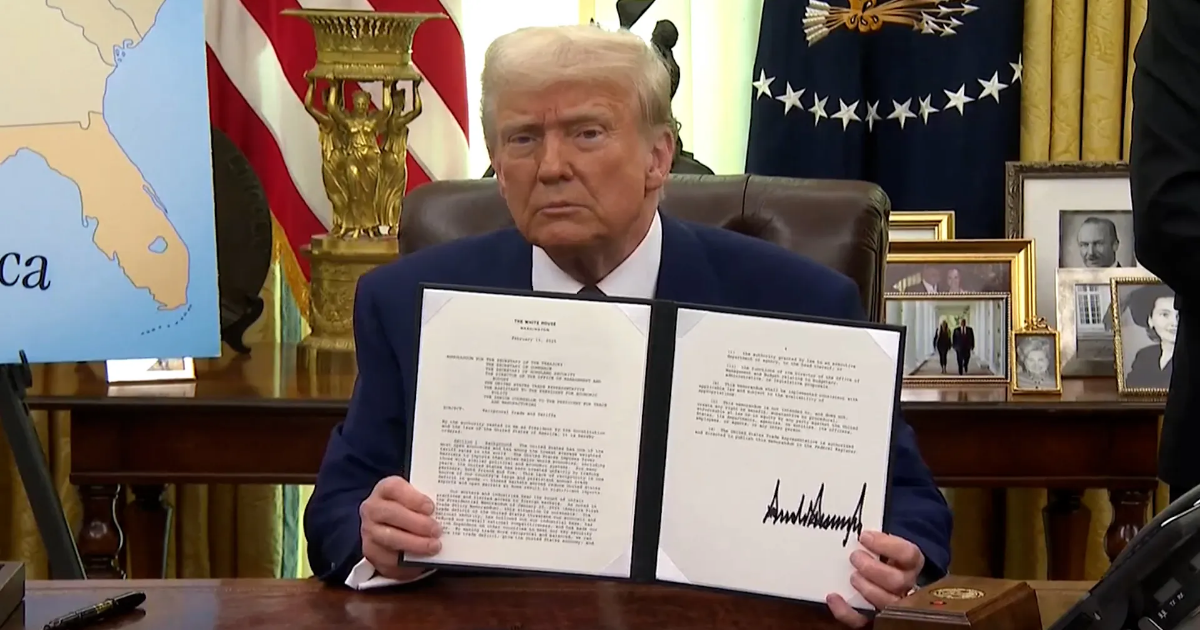
Tariffs on goods from Canada one day. Mexico the next. Now it’s cars.
In his first months back in office, President Donald Trump has at times gone heavy on tariff talk and then occasionally scaled back on tariffs – essentially, taxes on imports.
Trump told reporters in the Oval Office on Wednesday he will put tariffs on automobile imports next. He also announced plans this week to impose tariffs on countries that deal with Venezuela.
The president’s announcements this week mark a significant change from earlier in the month when he backpedaled on plans to tariff goods from Mexico and Canada amid consumer anxiety and falling stock prices.
Trump’s tariffs gambit has proved dizzying to follow. As the president announces new plans to raise tariff on automobile imports, here’s what to know about who will be impacted and when.
What’s the point of raising tariffs?
Tariffs have historically been used to bolster domestic industry by making sure foreign manufacturers can’t sell goods in the country at prices that undercut American manufacturers.
The tax policy was widely used throughout the 19th century in America and even through the mid-20th century. But tariffs have fallen out of vogue in recent decades as many economists say that ultimately costs from tariffs are passed onto consumers.
Some countries still use tariffs to bolster select industries and some countries impose tariffs on American imports disproportionately to what the U.S. taxes their goods.
Trump and Vice President JD Vance have argued leveling tariffs on a broad set of industries will boost the nation’s declining manufacturing sectors.
What’s the potential down side of the latest tariff increases?
Trump campaigned on a promise to use tariffs to bolster American manufacturing – automaking in particular – and on Wednesday he announced plans to impose tariffs on automobile imports. The president told reporters tariffs on auto imports will start at 2.5% and rise to 25%.
“We’re going to charge countries for doing business in our country and taking jobs, taking our wealth, taking so much out of our country,” Trump said. “This is very modest.”
Some experts worry raising tariffs won’t work as intended.
In a Wednesday morning sales forecast call, Cox Automotive chief economist Jonathan Smoke said massive increases in tariffs would be “highly disruptive” to North American vehicle production, potentially leading to tighter supply, higher prices and a “much weaker economy.”
Without carve-outs for automobiles and parts, Smoke said the auto market could be facing the highest effective tariff rate since World War II. Costs to make a vehicle assembled in Canada or Mexico could go up $6,000 or more, he said, while higher costs for parts could increase production costs for U.S.-made vehicles by roughly $3,000.
The U.S. imported $474 billion worth of automotive products in 2024, including passenger cars worth $220 billion. Mexico, Japan, South Korea, Canada and Germany, all close U.S. allies, were the biggest suppliers.
What effect are the tariffs having on the stock market?
U.S. stocks tumbled in after-hours trading after the auto announcement. Futures contracts tied to the broad S&P 500 index were down more than 1%, while those linked to the tech-heavy Nasdaq were off nearly 2% in the late afternoon.
Automaker stocks were also lower: General Motors Company shares lost nearly 5% and shares of Ford Motor Company, the only major U.S. carmaker to end the trading day higher, were more than 2% lower.
Stocks have been on a roller coaster ride as Trump has announced, then walked back, various rounds of tariffs over the past several weeks. Consumer sentiment has also been battered, and inflation expectations have spiked, concerning some Federal Reserve members.
What are reciprocal tariffs?
Reciprocal tariffs – taxes on imports equal to what other countries tariff American goods – are among the next expected to go into place.
Trump has promised reciprocal tariffs will take effect on April 2, offsetting trade practices the administration considers unfair.
“They charge us, and we charge them,” Trump said in announcing plans for the tariffs.
The president has talked about raising reciprocal tariffs in particular as a way of getting even with the European Union.
Tariffs on average are similar between the U.S. and EU, according to a JP Morgan analysis. But the EU taxes certain imports far more than America does. For example, the EU imposes a 10% tariff on American autos, compared to just 2.5% for European cars coming into the U.S., the report says.
Using tariffs to send a message
The Trump administration has also taken to threatening tariffs as a sort of political cudgel.
Venezuela is the latest country at which Trump has taken aim.
On Monday, he promised to raise a 25% tariff on goods from any country that buys oil and gas from the South American country that has some of the largest reserves in the world.
Trump views Venezuela as an enemy and said the tariffs are in retaliation to what he characterized as the country intentionally flooding the U.S. with gang members. He provided no evidence to support the claim.



